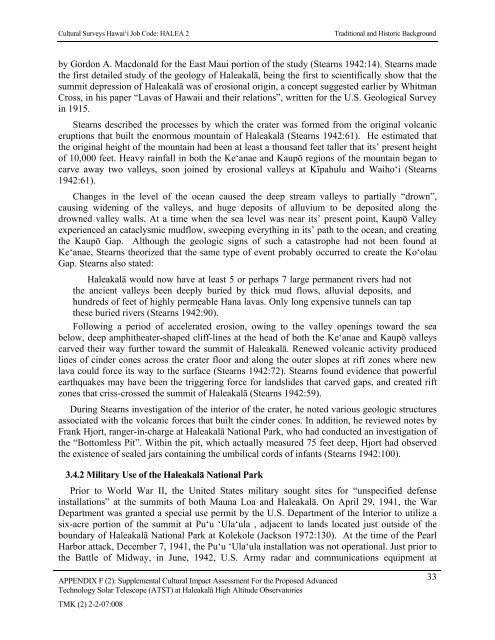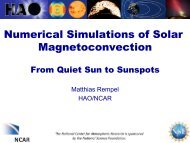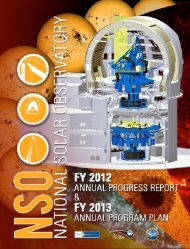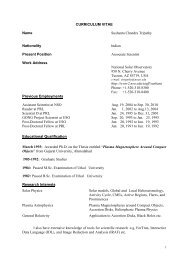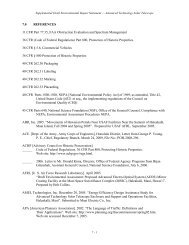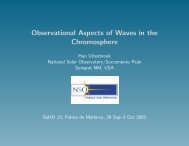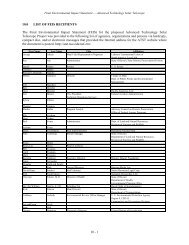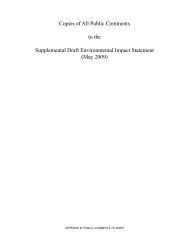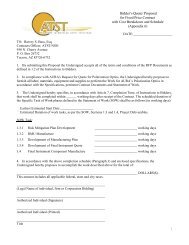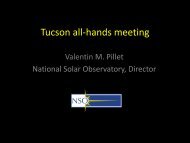F2 - ATST
F2 - ATST
F2 - ATST
You also want an ePaper? Increase the reach of your titles
YUMPU automatically turns print PDFs into web optimized ePapers that Google loves.
Cultural Surveys Hawai‘i Job Code: HALEA 2Traditional and Historic Backgroundby Gordon A. Macdonald for the East Maui portion of the study (Stearns 1942:14). Stearns madethe first detailed study of the geology of Haleakalā, being the first to scientifically show that thesummit depression of Haleakalā was of erosional origin, a concept suggested earlier by WhitmanCross, in his paper “Lavas of Hawaii and their relations”, written for the U.S. Geological Surveyin 1915.Stearns described the processes by which the crater was formed from the original volcaniceruptions that built the enormous mountain of Haleakalā (Stearns 1942:61). He estimated thatthe original height of the mountain had been at least a thousand feet taller that its’ present heightof 10,000 feet. Heavy rainfall in both the Ke‘anae and Kaupō regions of the mountain began tocarve away two valleys, soon joined by erosional valleys at Kīpahulu and Waiho‘i (Stearns1942:61).Changes in the level of the ocean caused the deep stream valleys to partially “drown”,causing widening of the valleys, and huge deposits of alluvium to be deposited along thedrowned valley walls. At a time when the sea level was near its’ present point, Kaupō Valleyexperienced an cataclysmic mudflow, sweeping everything in its’ path to the ocean, and creatingthe Kaupō Gap. Although the geologic signs of such a catastrophe had not been found atKe‘anae, Stearns theorized that the same type of event probably occurred to create the Ko‘olauGap. Stearns also stated:Haleakalā would now have at least 5 or perhaps 7 large permanent rivers had notthe ancient valleys been deeply buried by thick mud flows, alluvial deposits, andhundreds of feet of highly permeable Hana lavas. Only long expensive tunnels can tapthese buried rivers (Stearns 1942:90).Following a period of accelerated erosion, owing to the valley openings toward the seabelow, deep amphitheater-shaped cliff-lines at the head of both the Ke‘anae and Kaupō valleyscarved their way further toward the summit of Haleakalā. Renewed volcanic activity producedlines of cinder cones across the crater floor and along the outer slopes at rift zones where newlava could force its way to the surface (Stearns 1942:72). Stearns found evidence that powerfulearthquakes may have been the triggering force for landslides that carved gaps, and created riftzones that criss-crossed the summit of Haleakalā (Stearns 1942:59).During Stearns investigation of the interior of the crater, he noted various geologic structuresassociated with the volcanic forces that built the cinder cones. In addition, he reviewed notes byFrank Hjort, ranger-in-charge at Haleakalā National Park, who had conducted an investigation ofthe “Bottomless Pit”. Within the pit, which actually measured 75 feet deep, Hjort had observedthe existence of sealed jars containing the umbilical cords of infants (Stearns 1942:100).3.4.2 Military Use of the Haleakalā National ParkPrior to World War II, the United States military sought sites for “unspecified defenseinstallations” at the summits of both Mauna Loa and Haleakalā. On April 29, 1941, the WarDepartment was granted a special use permit by the U.S. Department of the Interior to utilize asix-acre portion of the summit at Pu‘u ‘Ula‘ula , adjacent to lands located just outside of theboundary of Haleakalā National Park at Kolekole (Jackson 1972:130). At the time of the PearlHarbor attack, December 7, 1941, the Pu‘u ‘Ula‘ula installation was not operational. Just prior tothe Battle of Midway, in June, 1942, U.S. Army radar and communications equipment atAPPENDIX F (2): Supplemental Cultural Impact Assessment For the Proposed Advanced 33Technology Solar Telescope (<strong>ATST</strong>) at Haleakalā High Altitude ObservatoriesTMK (2) 2-2-07:008


